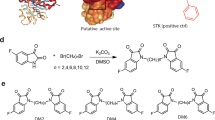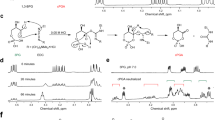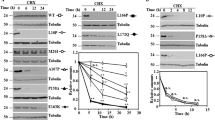Abstract
DJ-1 is a multifunctional protein associated with cancers and autosomal early-onset Parkinson disease. Besides the well-documented antioxidative stress activity, recent studies show that DJ-1 has deglycation enzymatic activity and anti-ferroptosis effect. It has been shown that DJ-1 forms the homodimerization, which dictates its antioxidative stress activity. In this study, we investigated the relationship between the dimeric structure of DJ-1 and its newly reported activities. In HEK293T cells with Flag-tagged and Myc-tagged DJ-1 overexpression, we performed deletion mutations and point mutations, narrowed down the most critical motif at the C terminus. We found that the deletion mutation of the last three amino acids at the C terminus of DJ-1 (DJ-1 ΔC3) disrupted its homodimerization with the hydrophobic L187 residue being of great importance for DJ-1 homodimerization. In addition, the ability in methylglyoxal (MGO) detoxification and deglycation was almost abolished in the mutation of DJ-1 ΔC3 and point mutant L187E compared with wild-type DJ-1 (DJ-1 WT). We also showed the suppression of erastin-triggered ferroptosis in DJ-1−/− mouse embryonic fibroblast cells was abolished by ΔC3 and L187E, but partially diminished by V51C. Thus, our results demonstrate that the C terminus of DJ-1 is crucial for its homodimerization, deglycation activity, and suppression of ferroptosis.
Similar content being viewed by others
Log in or create a free account to read this content
Gain free access to this article, as well as selected content from this journal and more on nature.com
or
References
Nagakubo D, Taira T, Kitaura H, Ikeda M, Tamai K, Iguchi-Ariga SMM, et al. DJ-1, a novel oncogene which transforms mouse NIH3T3 cells in cooperation with ras. Biochem Biophys Res Commun. 1997;231:509–13.
Zhang L, Shimoji M, Thomas B, Moore D, Yu S-W, Marupudi N, et al. Mitochondrial localization of the Parkinson’s disease related protein DJ-1: implications for pathogenesis. Hum Mol Genet. 2005;14:2063–73.
Bonifati V, Rizzu P, Baren M, Schaap O, Breedveld G, Krieger E, et al. Mutations in the DJ-1 gene associated with autosomal recessive early-onset parkinsonism. Science. 2003;299:256–9.
Le Naour F, Misek DE, Krause MC, Deneux L, Giordano TJ, Scholl S, et al. Proteomics-based identification of RS/DJ-1 as a novel circulating tumor antigen in breast cancer. Clin Cancer Res. 2001;7:3328–35.
Oh SE, Mouradian MM. Cytoprotective mechanisms of DJ-1 against oxidative stress through modulating ERK1/2 and ASK1 signal transduction. Redox Biol. 2018;14:211–7.
Tian M, Cui YZ, Song GH, Zong MJ, Zhou XY, Chen Y, et al. Proteomic analysis identifies MMP-9, DJ-1 and A1BG as overexpressed proteins in pancreatic juice from pancreatic ductal adenocarcinoma patients. BMC Cancer. 2008;8:241.
Cao J, Lou S, Ying M, Yang B. DJ-1 as a human oncogene and potential therapeutic target. Biochem Pharmacol. 2014;93:241–50.
Kim RH, Peters M, Jang Y, Shi W, Pintilie M, Fletcher GC, et al. DJ-1, a novel regulator of the tumor suppressor PTEN. Cancer Cell. 2005;7:263–73.
Takahashi-Niki K, Kato-Ose I, Murata H, Maita H, Ariga S, Ariga H. Epidermal growth factor-dependent activation of the extracellular signal-regulated kinase pathway by DJ-1 protein through its direct binding to c-Raf protein. J Biol Chem. 2015;290:17838–47.
Clements C, McNally R, Conti B, Duncan G, Ting J. DJ1, a cancer and Parkinson’s disease-associated protein, stabilizes the antioxidant transcriptional master regulator Nrf2. Proc Natl Acad Sci USA. 2006;103:15091–6.
Bahmed K, Boukhenouna S, Karim L, Andrews T, Lin J, Powers R, et al. The effect of cysteine oxidation on DJ-1 cytoprotective function in human alveolar type II cells. Cell Death Dis. 2019;10:638.
Kiss R, Zhu M, Jójárt B, Czajlik A, Solti K, Fórizs B, et al. Structural features of human DJ-1 in distinct Cys106 oxidative states and their relevance to its loss of function in disease. Biochim Biophys Acta Gen Subj. 2017;1861:2619–29.
Wilson MA. The role of cysteine oxidation in DJ-1 function and dysfunction. Antioxid Redox Signal. 2011;15:111–22.
Kinumi T, Kimata J, Taira T, Ariga H, Niki E. Cysteine-106 of DJ-1 is the most sensitive cysteine residue to hydrogen peroxide-mediated oxidation in vivo in human umbilical vein endothelial cells. Biochem Biophys Res Commun. 2004;317:722–8.
Taira T, Saito Y, Niki T, Iguchi-Ariga SMM, Takahashi K, Ariga H. DJ-1 has a role in antioxidative stress to prevent cell death. EMBO Rep. 2004;5:213–8.
Canet-Avilés RM, Wilson MA, Miller DW, Ahmad R, McLendon C, Bandyopadhyay S, et al. The Parkinson’s disease protein DJ-1 is neuroprotective due to cysteine-sulfinic acid-driven mitochondrial localization. Proc Natl Acad Sci USA. 2004;101:9103–8.
Blackinton J, Lakshminarasimhan M, Thomas KJ, Ahmad R, Greggio E, Raza AS, et al. Formation of a stabilized cysteine sulfinic acid is critical for the mitochondrial function of the parkinsonism protein DJ-1. J Biol Chem. 2009;284:6476–85.
Raninga P, Di Trapani G, Tonissen K. The multifaceted roles of DJ-1 as an antioxidant. In: Ariga H, Iguchi-Ariga SMM, editors. DJ-1/PARK7 protein. Singapore: Springer; 2017. p. 67–87.
Cao J, Chen X, Jiang L, Lu B, Yuan M, Zhu D, et al. DJ-1 suppresses ferroptosis through preserving the activity of S-adenosyl homocysteine hydrolase. Nat Commun. 2020;11:1251.
Cao J, Ying M, Xie N, Lin G, Dong R, Zhang J, et al. The oxidation states of DJ-1 dictate the cell fate in response to oxidative stress triggered by 4-hpr: autophagy or apoptosis? Antioxid Redox Signal. 2014;21:1443–59.
Dolgacheva LP, Berezhnov AV, Fedotova EI, Zinchenko VP, Abramov AY. Role of DJ-1 in the mechanism of pathogenesis of Parkinson’s disease. J Bioenerg Biomembr. 2019;51:175–88.
Xu C-Y, Kang W-Y, Chen Y-M, Jiang T-F, Jia Z, Zhang L-N, et al. DJ-1 inhibits α-synuclein aggregation by regulating chaperone-mediated autophagy. Front Aging Neurosci. 2017;9:308.
Meulener MC, Graves CL, Sampathu DM, Armstrong-Gold CE, Bonini NM, Giasson BI. DJ-1 is present in a large molecular complex in human brain tissue and interacts with α-synuclein. J Neurochem. 2005;93:1524–32.
Inden M, Taira T, Kitamura Y, Yanagida T, Tsuchiya D, Takata K, et al. PARK7 DJ-1 protects against degeneration of nigral dopaminergic neurons in Parkinson’s disease rat model. Neurobiol Dis. 2006;24:144–58.
Lee J-y, Song J, Kwon K, Jang S, Kim C, Baek K, et al. Human DJ-1 and its homologs are novel glyoxalases. Hum Mol Genet. 2012;21:3215–25.
Subedi KP, Choi D, Kim I, Min B, Park C. Hsp31 of Escherichia coli K-12 is glyoxalase III. Mol Microbiol. 2011;81:926–36.
Misra K, Banerjee AB, Ray S, Ray M. Glyoxalase III from Escherichia coli: a single novel enzyme for the conversion of methylglyoxal into D-lactate without reduced glutathione. Biochem J. 1995;305:999–1003.
Richarme G, Marguet E, Forterre P, Ishino S, Ishino Y. DJ-1 family Maillard deglycases prevent acrylamide formation. Biochem Biophys Res Commun. 2016;478:1111–6.
Mihoub M, Abdallah J, Richarme G. Protein repair from glycation by glyoxals by the DJ-1 family Maillard deglycases. In: Ariga H, Iguchi-Ariga SMM, editors. DJ-1/PARK7 protein. Singapore: Springer; 2017. p. 133–47.
Richarme G, Liu C, Mihoub M, Abdallah J, Léger T, Joly N, et al. Guanine glycation repair by DJ-1/Park7 and its bacterial homologs. Science. 2017;357:208–11.
Richarme G, Mihoub M, Dairou J, Bui L-C, Léger T, Lamouri A. Parkinsonism-associated protein DJ-1/Park7 is a major protein deglycase that repairs methylglyoxal- and glyoxal-glycated cysteine, arginine, and lysine residues. J Biol Chem. 2015;290:1885–97.
Honbou K, Noda N, Horiuchi M, Niki T, Taira T, Ariga H, et al. The crystal structure of DJ-1, a protein related to male fertility and Parkinson’s disease. J Biol Chem. 2003;278:31380–4.
Tao X, Tong L. Crystal structure of human DJ-1, a protein associated with early onset Parkinson’s disease. J Biol Chem. 2003;278:31372–9.
Wilson MA, Collins JL, Hod Y, Ringe D, Petsko GA. The 1.1-Å resolution crystal structure of DJ-1, the protein mutated in autosomal recessive early onset Parkinson’s disease. Proc Natl Acad Sci USA. 2003;100:9256–61.
Görner K, Holtorf E, Waak J, Pham T-T, Vogt Weisenhorn D, Wurst W, et al. Structural determinants of the C-terminal helix-kink-helix motif essential for protein stability and survival promoting activity of DJ-1. J Biol Chem. 2007;282:13680–91.
Alvarez-Castelao B, Muñoz C, Sánchez I, Goethals M, Vandekerckhove J, Castaño J. Reduced protein stability of human DJ-1/PARK7 L166P, linked to autosomal recessive Parkinson disease, is due to direct endoproteolytic cleavage by the proteasome. Biochim Biophys Acta. 2011;1823:524–33.
Anderson P, Daggett V. Molecular basis for the structural instability of human DJ-1 induced by the L166P mutation associated with Parkinson’s disease †. Biochemistry. 2008;47:9380–93.
Miller D, Ahmad R, Hague S, Canet-Aviles R, McLendon C, Carter D, et al. L166P mutant DJ-1, causative for recessive Parkinson’s disease, is degraded through the ubiquitin-proteasome system. J Biol Chem. 2003;278:36588–95.
Pfaff D, Fleming T, Nawroth P, Teleman A. Evidence against a role for the Parkinsonism-associated protein DJ-1 in methylglyoxal detoxification. J Biol Chem. 2016;292:685–90.
Thornalley P. Glyoxalase I—structure, function and a critical role in the enzymatic defence against glycation. Biochem Soc Trans. 2003;31:1343–8.
Zhou H-H, Chen X, Cai LY, Nan XW, Chen JH, Chen XX, et al. Erastin reverses ABCB1-mediated docetaxel resistance in ovarian cancer. Front Oncol. 2019;9:1398.
Xie Y, Hou W, Song X, Yu Y, Huang J, Sun X, et al. Ferroptosis: process and function. Cell Death Differ. 2016;23:369–79.
Chan J, Chan SHH. Activation of endogenous antioxidants as a common therapeutic strategy against cancer, neurodegeneration and cardiovascular diseases: a lesson learnt from DJ-1. Pharmacol Ther. 2015;156:69–74.
Moore DJ, Zhang L, Troncoso J, Lee MK, Hattori N, Mizuno Y, et al. Association of DJ-1 and parkin mediated by pathogenic DJ-1 mutations and oxidative stress. Hum Mol Genet. 2005;14:71–84.
Olzmann JA, Brown K, Wilkinson KD, Rees HD, Huai Q, Ke H, et al. Familial Parkinson’s disease-associated L166P mutation disrupts DJ-1 protein folding and function. J Biol Chem. 2004;279:8506–15.
Baulac S, LaVoie MJ, Strahle J, Schlossmacher MG, Xia W. Dimerization of Parkinson’s disease-causing DJ-1 and formation of high molecular weight complexes in human brain. Mol Cell Neurosci. 2004;27:236–46.
Herrera FE, Zucchelli S, Jezierska A, Lavina ZS, Gustincich S, Carloni P. On the oligomeric state of DJ-1 protein and its mutants associated with Parkinson disease. A combined computational and in vitro study. J Biol Chem. 2007;282:24905–14.
Fernandez-Caggiano M, Schröder E, Cho H-J, Burgoyne J, Barallobre-Barreiro J, Mayr M, et al. Oxidant-induced interprotein disulfide formation in cardiac protein DJ-1 occurs via an interaction with peroxiredoxin 2. J Biol Chem. 2016;291:10399–410.
Drechsel J, Mandl FA, Sieber SA. Chemical probe to monitor the parkinsonism-associated protein DJ-1 in live cells. ACS Chem Biol. 2018;13:2016–9.
Tashiro S, Caaveiro JMM, Nakakido M, Tanabe A, Nagatoishi S, Tamura Y, et al. Discovery and optimization of inhibitors of the Parkinson’s disease associated protein DJ-1. ACS Chem Biol. 2018;13:2783–93.
Acknowledgements
This work was supported by grants from National Science & Technology Major Project “Key New Drug Creation and Manufacturing Program”, China (2018ZX09711002 to HZ), the National Natural Science Foundation of China (No. 81773757 to MDY; No. 81402951 to JC), and Zhejiang Medical and Health Science and Technology Program (No. 2020384517 to CYD).
Author information
Authors and Affiliations
Contributions
JC, LJ, and XBC designed the research and wrote the paper; LJ, XBC, QW, HYZ, CYD performed the biochemical and cellular studies; JC, LJ, XBC, HZ, and MDY analyzed the results; JC, HZ, MDY, QJH, and BY directed the study.
Corresponding author
Ethics declarations
Competing interests
The authors declare that they have no conflict of interest.
Supplementary information
Rights and permissions
About this article
Cite this article
Jiang, L., Chen, Xb., Wu, Q. et al. The C terminus of DJ-1 determines its homodimerization, MGO detoxification activity and suppression of ferroptosis. Acta Pharmacol Sin 42, 1150–1159 (2021). https://doi.org/10.1038/s41401-020-00531-1
Received:
Accepted:
Published:
Issue date:
DOI: https://doi.org/10.1038/s41401-020-00531-1
Keywords
This article is cited by
-
Neuroprotective role and mechanistic insights of DJ-1 dimerization in Parkinson’s disease
Cell Communication and Signaling (2025)
-
DJ-1 upregulates the Nrf2/GPX4 signal pathway to inhibit trophoblast ferroptosis in the pathogenesis of preeclampsia
Scientific Reports (2022)
-
Bis-isatin derivatives: design, synthesis, and biological activity evaluation as potent dimeric DJ-1 inhibitors
Acta Pharmacologica Sinica (2021)



